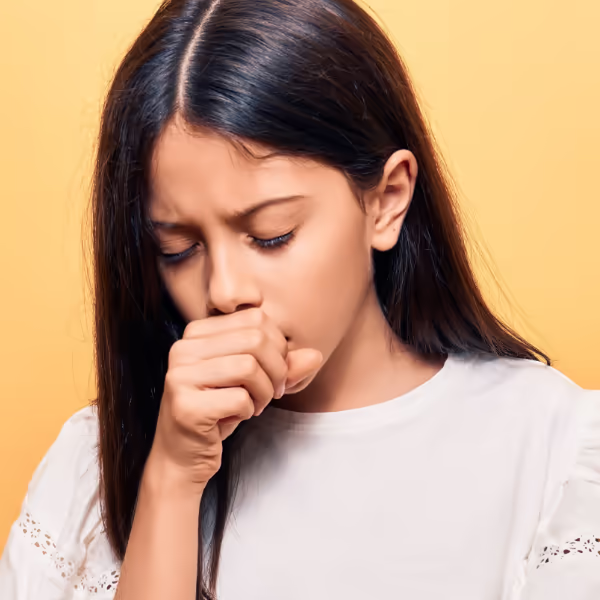Wheezing in Children
What is wheezing?
Wheezing is a high-pitched, whistling sound that happens when a child breathes out (and sometimes when they breathe in). It is caused by air passing through narrowed or inflamed airways in the lungs.
Wheezing is a common symptom in young children and can be associated with many conditions. While asthma is a frequent cause in older children, wheezing in babies and preschoolers is often due to viral infections or other structural or developmental airway differences.
Causes of Wheezing in Children
Wheezing is a symptom, not a diagnosis, and may be caused by a range of conditions:
1. Viral Respiratory Infections (e.g. Bronchiolitis)
- Most common cause in babies and toddlers under 2 years old
- Typically caused by viruses such as RSV, rhinovirus, or influenza
- Airways become swollen and filled with mucus, leading to cough, wheeze, and difficulty breathing
- May occur as a one-off episode or recur with each viral illness

2. Pre-school Wheeze (also called Viral-Induced Wheeze)
- Affects children aged 1–5 years
- Wheeze is triggered by viral infections, cold air, or other irritants
- Many children outgrow this by the time they start school
- These children may not necessarily go on to develop asthma
3. Toddler Asthma
- A chronic condition involving inflamed, sensitive airways
- Common in older children, or those with a personal or family history of eczema, hay fever, or asthma
- Triggers include viral infections, exercise, cold air, allergens, and smoke
- Symptoms include recurrent wheezing, cough, chest tightness, and breathlessness
4. Structural Airway Problems (e.g. Bronchomalacia, Laryngomalacia)
- In younger infants, especially those who have always wheezed from birth
- Airways are softer or more flexible than usual, collapsing slightly with breathing
- Symptoms are often worse with activity, crying, or feeding
- Usually improve with age
5. Inhaled Foreign Object
- Sudden onset of wheeze, cough, or choking, especially if it affects one side of the chest
- Most common in toddlers who may accidentally inhale food or small objects
- Requires urgent medical evaluation
6. Other Less Common Causes
- Allergic reactions (including anaphylaxis)
- Reflux-related wheezing (acid reflux irritating the airways)
- Chronic lung conditions (e.g. cystic fibrosis, primary ciliary dyskinesia)
- Heart conditions
What Are the Symptoms of Wheezing?
- Whistling noise when breathing, especially on exhaling
- Fast breathing or shortness of breath
- Coughing, often worse at night or with colds
- Chest tightness or discomfort
- Use of chest or neck muscles to breathe (visible effort)
- In severe cases: blue lips, lethargy, or difficulty speaking or feeding
When to Seek Medical Help
Call 999 / emergency services if:
- Your child is struggling to breathe or has blue lips or face
- They are too breathless to talk or feed
- They suddenly develop wheeze after a possible inhaled object, sting, or food
Contact your GP or respiratory paediatrician if:
- Wheezing is persistent or worsening
- Your child is needing reliever medication every 3 hours or more
- You are unsure whether this is asthma or something else
Diagnosis of Wheezing
The cause of wheezing is often based on:
- Clinical history and examination
- Response to inhalers
- In older children: lung function tests (spirometry, FeNO)
- In persistent or atypical cases: chest X-ray, CT scan, bronchoscopy, or specialist referral
Treatment Options
Treatment depends on the cause of the wheeze:
1. Relievers (e.g. Salbutamol, Ventolin®)
- Help open up the airways
- Used during wheezing episodes
- Given via inhaler and spacer (and mask if needed)
2. Steroids
- Oral steroids (e.g. Prednisolone) may be used in more severe episodes
- Inhaled steroids (e.g. Flixotide®) may be prescribed for children with frequent wheeze to reduce airway inflammation
3. Avoidance of Triggers
- Avoid tobacco smoke exposure
- Treat allergic rhinitis or hay fever
- Reduce exposure to known allergens or irritants
4. Pre-School Wheeze Action Plan
- A written plan from your doctor to guide you on what to do when your child is unwell, including when to use inhalers or seek help.
Caring for Your Child at Home
- Use reliever inhaler as prescribed with a spacer
- Encourage small, frequent sips of fluids
- Use a cool mist humidifier or warm steam if recommended
- Avoid smoke exposure completely
- Keep a record of symptoms and response to medication
Will My Child Grow Out of Wheezing?
- Many young children with viral-induced wheeze improve as their lungs grow
- If your child has frequent wheeze or associated allergic conditions, they may be more likely to go on to develop asthma
- Early recognition, monitoring, and treatment can help reduce the impact on daily life
Follow-Up and Monitoring
- Children with recurrent wheezing should be reviewed regularly
- Follow-up is especially important after an emergency visit or hospitalisation
- Your child may benefit from input from a paediatric respiratory specialist if symptoms are frequent, severe, or not improving with standard treatment
Need Support or Further Advice?
If you’re concerned about your child’s breathing or wheezing symptoms, please contact your GP, or respiratory specialist. Early management can make a big difference.
Located in London | Infants to young adults seen
Request a referral or book an appointment with Professor Gupta today.
